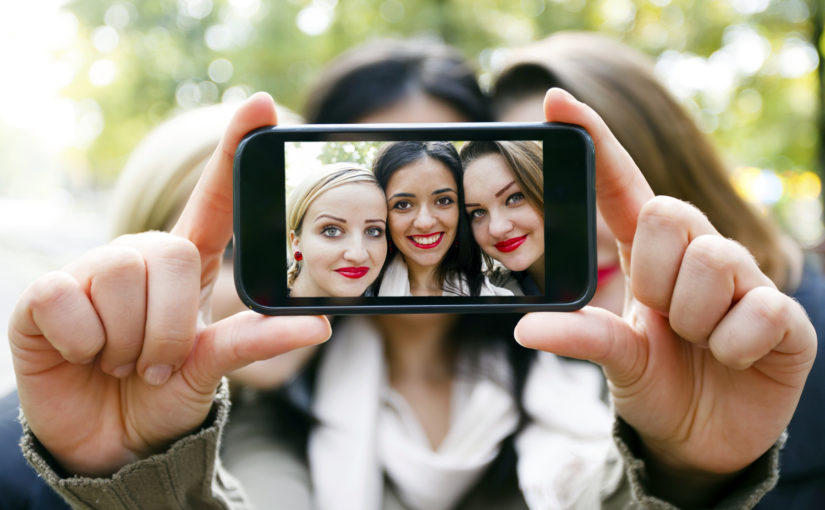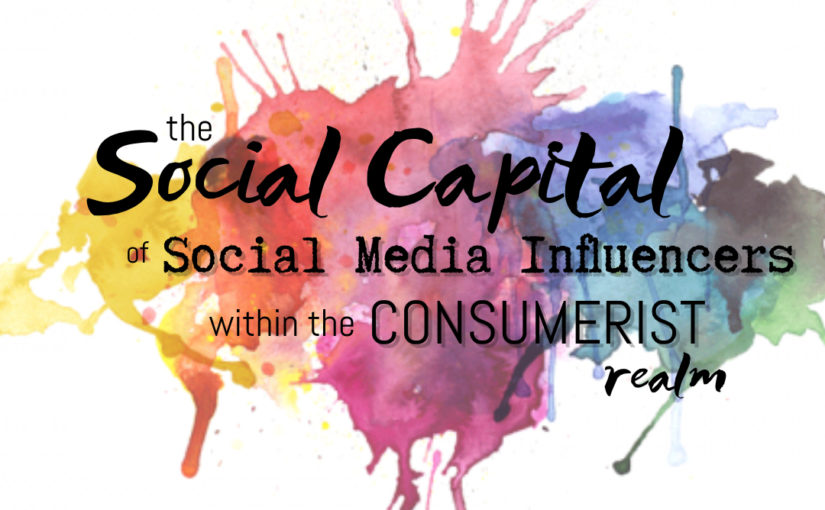Abstract
Social networking platforms allow users the ability to control how their identity is presented to others. In the case of Instagram, users can edit and add filters to photos of their choice to be seen by public or private audience. While these features can be used as a form of self-expression, there are often other motivations for performing identity through Instagram. This paper identifies these motivations and outlines the affect that false representations of reality can have on audiences. The paper will examine the work of various researchers on performing identity offline, online identity, social networking use, and Instagram use. The research discussed in this paper suggests that people modify their identity online to conceal negative aspects of themselves in order to achieve a desired impression on their audience, which often includes impressing their social groups and communities. This paper also identifies that distorted representations of identity can cause negative self-evaluation in audiences, who engage in social comparisons online.
Keywords: Identity, Instagram, Social Networks
Introduction
This paper will discuss the motivations for self-presentation of identity and how false performances of identity can impact others, with specific reference to Instagram. The paper will draw information from many researchers in the communications field to present the argument that since Instagram allows users to choose how to portray themselves, they can create false perceptions of their identity to others, which in turn, can have a negative impact on the self-evaluation of their audiences. These audiences consist of the user’s offline communities, including friends, family and acquaintances, as well as their online social networks.
According to Pearson (2009), people online can “deliberately choose to put forth identity cues or claims of self that can closely resemble or widely differ from reality”. Due to the nature of online profiles, users do not accurately depict themselves but rather articulate chosen performances (boyd & Heer, 2006). The “performer” manages disclosure on social networking sites, choosing whether to share more private aspects of their constructed identity (Pearson, 2009). Furthermore, social networking platforms with fluidity allow for users to “play with aspects of their presentation of self” while communicating with others (Pearson, 2009). Through the social networking site Instagram, users often present their identity to make themselves appear more favourable, which can induce negative comparisons from their audience who may feel jealous or view their own life in a less positive light.
Presentation of Identity Online
Since the way people present themselves online can be significantly different from how they present themselves offline, it is believed that communicating with others in various contexts involves showing different aspects of one’s identity according to the situation (Goffman, 1959; Lazebna, 2015). According to Rettberg (2014, p. 51), when posting a photo to Instagram, people intentionally choose what they “want to remember and share” and what they “want to leave out”. Individuals will conceal aspects that could be perceived negatively and only share positive situations (Seehafer, 2017). Rosenberg and Egbert (2011, p. 4) define the process in which individuals regulate their own behaviour to expose desirable traits as “self-monitoring”. This involves creating strategic profiles and engaging in self-presentation tactics to expose their identity in a favourable light and have a desired impression on an audience (Rosenberg & Egbert, 2011; Seehafer, 2017).
Performances of identity in social networks start within the imagination of users and then are brought to existence with the aid of the tools and technologies of the platform, allowing users to “project, renegotiate, and continuously revise their consensual social hallucination” (Pearson, 2009). It is expected for audiences to believe the online content of others to depict accurate representations of identity that mirror reality, when instead these performances may not be genuine (Goffman, 1959; Seehafer, 2017). In contrast, Lee (2006) argues that self-presentation online is dependent on context, and therefore, interaction is not necessarily dishonest and deceptive. This argument supports Hardey’s (2002, p. 570) belief that rather than constructing “fantasy selves”, anonymous online interactions act as a foundation for building trust and establishing relationships.
Presentation of self on Instagram is mainly made up of an individual’s username, pictures and descriptions, profile photo, and bio, all of which take a part in constructing a user’s online identity. Users often upload photos of themselves with friends, at events, and “selfies” to make their life appear a certain way. A study by Adler (2017), found that the primary motivation for posting selfies was for ego-reinforcement, as these individuals feel better about themselves when receiving likes from others. In contrast to the arguments made in this paper, Adler’s (2017) study also found that participants posted selfies due to high levels of self-esteem and confidence, with one participant stating that posting selfies acted as a way for her to build her self-confidence and show love and appreciation for herself. While some Instagram users may present their identity candidly and confidently, many others use online identity as an opportunity to shape themselves as more favourable to others.
Using Online Identity to Belong
Much of the research into the way in which people present themselves to others is based on Goffman’s (1959) belief that individuals modify their identity to adhere to societal understandings and expectations. Goffman (1959) believes that people become characters that play out a performance when interacting with others to achieve a desired impression. Goffman’s beliefs can be applied to the modern Web 2.0 context whereby online users maintain their character and express performances through their social networking platforms, which have grown to become a fundamental factor in the management of identity and social relations (Mascheroni, Vincent, & Jimenez, 2015; Seehafer, 2017). According to Rosenberg and Egbert (2011, p. 5), individuals use self-presentation tactics in order to “make a desired impression on a particular audience”. The motivation for this is derived from individuals’ intrinsic need for acceptance and inclusion (Rosenberg & Egbert, 2011).
According to Pearson (2009), people construct their identities in relation to their networks and communities. People can often feel pressured to fit in with a certain group identity through the construction of their online identity, which can affect one’s reputation within a community (Kollock & Smith, 1999; Rettberg, 2014). Furthermore, Kollock and Smith (1999) argue that upholding and developing one’s identity or reputation is actually essential to the formation of communities. In modern society, people create and update online profiles that conform to society’s standards of self-presentation and social expectations (Mascheroni, Vincent, & Jiminez, 2015). The motivation for individuals to carefully manage and monitor the impressions made by their online identity is enhanced by the public nature of social network profiles (Rosenberg & Egbert, 2011).
One way that individuals try to impress their social groups on their social networks, mainly through Facebook and Instagram, is through uploading photos from particular events. According to boyd and Heer (2006), uploading event photos indicates “friendship structure to outsiders and an expression of appreciation to friends”, which displays participation and inclusion. Instagram has a feature that enables users to tag other people depicted in pictures and add the location that the photo was taken (Ridgway & Clayton, 2016). Additionally, each user’s profile has a “Tagged In” section that shows viewers all the photos that user has been tagged in. Tagging friends in photos can enhance the feeling of community online between friends. It can also help to achieve a desired impression on audiences, possibly that the individual is popular if they upload photos with many people.
Using Filters to Alter Reality
Rettberg (2014) argues that people upload photos to Instagram to heighten their own daily experiences and make themselves feel special. Instagram allows users to edit their photos and apply various filters that may conceal aspects of their performance (Seehafer, 2017). Filters are manipulation tools that can be used as a form of self-expression, involving the ability to adjust brightness, colour, saturation, and various other qualities (Hochman & Manovich, 2013; Seehafer, 2017). Instagram filters can create a different “feel” by altering the message communicated by the image (Hochman & Manovich, 2013). Using filters on photos allows for individuals to see themselves from a distance that “makes them new” (Rettberg, 2014, p. 27). By editing and using filters on photos, people are able to display an idealised image of “a socially-accepted and desirable persona” (Lazebna, 2015, p. 2). This idea is supported by Seehafer (2017), who argues that performances of identity online are expected to meet ideal standards and disguise everything that does not fit into these standards.
A study by Reece and Danforth (2017) found that depressed individuals were less likely to apply filters to their photos than healthy individuals. Additionally, the depressed participants preferred a black and white filter as opposed to the healthy participants that favoured the Valencia filter, which lightens the tint of the photo (Reece & Danforth, 2017). This suggests that people who are not depressed are the ones that are more likely to use filters on their photos, and hence, take notice of their impression management.
The Effect of Online Performances of Identity on Others
Since social media platforms allow for users to control how they present themselves to others, they contain idealised versions of identity (Hendrickse, 2016). According to Appel, Gerlach and Crusius (2016, p. 44), information presented online is positively skewed, increasing the “probability of unflattering social comparisons”. According to Wood (1996), social comparison refers to comparing oneself to others in terms of self-evaluation, self-improvement and/or self-enhancement. Social comparisons can result in envy, which is heightened when one compares themselves to their friends and peers due to its high personal relevance (Appel, Gerlach & Crusius, 2016). Vogel, Rose, Okdie, Eckles and Franz (2015) support this idea by arguing that social comparisons on social media construct negative effects on well-being and self-evaluation. Goffman (1959) suggests that social distance assists in generating admiration within an audience. This distance is enhanced in an online environment, especially between individuals that have not met offline as a comparison does not require direct contact (Wood, 1996). As many individuals use social networking sites to learn about others without engaging in any social interaction, the likelihood for social comparisons to occur is very high (Vogel et al, 2015; Wood, 1996). This not only involves looking at the profiles of family, friends and acquaintances but also those of strangers, whether famous, a friend of a friend or someone with no social connection whatsoever.
Many celebrities and models have an active presence on Instagram, with millions of followers that see every image they post. One of the most followed people on Instagram is Selena Gomez, who often shares photos containing her “thin-ideal body” (Hendrickse, 2016, p. 2). Gomez and other prominent Instagram influencers all have the ability to apply filters to their images, controlling the way others see them (Hendricks, 2016). While these body and beauty standards are conveyed through various social influences, the most prominent force is mass media, and therefore, social networking sites (Groesz, Levine & Murnen, 2002). A study by Shelly, Ward, Hyde and Shibley (2008) discovered that exposure to thin body images in the media positively relates to body image insecurities. This evidence is supported by Hendrickse’s (2016) study that found a strong relationship between body image concerns regarding thinness and appearance-related comparisons made on Instagram. Repeated exposure to such images in the media lead audiences to accept such portrayals as representations of reality, causing the thin ideal body to be seen as normal, and even expected (Shelly et al, 2008). Evidently, this affects many women’s satisfaction with their own body, and in turn, decreasing their self-esteem (Shelly et al, 2008).
Conclusion
Social networking sites provide a platform for people to represent their identity online through alternate performances (Pearson, 2009). On Instagram, users upload selfies as a way to perform their visual identity. Through performance, individuals engage in impression management in order to make a desired impression on an audience (Rosenberg & Egbert, 2011). Desired impressions are often based around fitting in with social groups, which can help users feel as if they belong within an online community. Rettberg (2014) argues that performance of visual identity online is coercive, and users feel pressured to display a group identity. Instagram allows users to tag others in photos, demonstrating inclusion and popularity while also enhancing the sense of community. Another feature that is widely used on Instagram is the ability to apply filters to photos. While filters may be used as artful expression, they are also a manipulation tool that can distort reality (Hochman & Manovich). Since users can control their performances online, identities often represent an idealised version of reality (Hendrickse, 2016). When viewing the profiles of others online, people use social comparisons by assessing their own life in contrast to the person online. Misrepresenting true identity online can cause audiences to experience negative self-evaluation, and even envy (Appel, Gerlach & Crusius, 2016; Vogel et al, 2015). Such social comparisons are present in examples of thin body performances throughout social media and Instagram. Overall, the affordances of social networking sites like Instagram allow users to perform their identity however they please, and false performances of identity can cause negative social comparisons from audiences.
References
Adler, N. (2017). Who Posts Selfies and Why?: Personality, Attachment Style, and Mentalization as Predictors of Selfie Posting on Social Media. (Masters’ Thesis). Retrieved from https://search-proquest-com.dbgw.lis.curtin.edu.au/docview/1979342189/B98AB26242254873PQ/1?accountid=10382
Appel, H., Gerlach, A. L., & Crusius, J. (2016). The interplay between Facebook use, social comparison, envy, and depression. Current Opinion in Psychology, 9, 44-49. doi:10.1016/j.copsyc.2015.10.006
boyd, d. (2006). Friends, Friendsters, and Top 8: Writing community into being on social network sites. First Monday, 11(2). Retrieved from http://firstmonday.org/ojs/index.php/fm/article/view/1418/1336
boyd, d., & Heer, J. (2006). Profiles as conversation: Networked identity performance on Friendster. Paper presented at the Hawai’i International Conference on System Sciences, Kauai. http://www.danah.org/papers/HICSS2006.pdf
Goffman, E. (1969). The presentation of self in everyday life. London : Allen Lane.
Groesz, L. M., Levine, M. P., & Murnen, S. K. (2002). The Effect of Experimental Presentation of Thin Media Images on Body Satisfaction: A Meta-Analytic Review. (Vol. 31, pp. 1-16). New York.
Hardey, M. (2002). Life beyond the screen: embodiment and identity through the internet. The Sociological Review, 50(4), 570-585. doi: 10.1177/003802610205000406
Hendrickse, J. (2016). Appearance-related comparisons mediate the relationship between Instagram use and body image concerns. (Masters’ thesis). Retrieved from https://search-proquest-com.dbgw.lis.curtin.edu.au/docview/1873209467/DA8D20FC83F54BF9PQ/5?accountid=10382
Hochman, N., & Manovich, L. (2013). Zooming into an Instagram City: Reading the local through social media. First Monday, 18(7). http://dx.doi.org/10.5210/fm.v18i7.4711.
Kollock, P., & Smith, M. A. (1999). Communities in cyberspace. Retrieved from https://ebookcentral.proquest.com/lib/curtin/detail.action?docID=168601
Lazebna, A. (2015). The role of communication apprehension, expression of the true self, and fear of negative evaluation in relation to Instagram and selfie use. (Masters’ thesis). Retrieved from https://search-proquest-com.dbgw.lis.curtin.edu.au/docview/1730242457?accountid=10382
Lee, H. (2006). Privacy, Publicity, and Accountability of Self‐Presentation in an On‐Line Discussion Group. Sociological Inquiry, 76(1), 1-22. doi:10.1111/j.1475-682X.2006.00142.x
Mascheroni, G., Vincent, J., & Jimenez, E. (2015). “Girls are addicted to likes so they post semi-naked selfies”: Peer mediation, normativity and the construction of identity online. Cyberpsychology: Journal of Psychological Research on Cyberspace, 9(1). http://dx.doi.org/10.5817/CP2015-1-5
Pearson, E. (2009). All the World Wide Web’s a stage: The performance of identity in online social networks. First Monday, 14(3). http://dx.doi.org/10.5210/fm.v14i3.2162
Reece, A. G., & Danforth, C. M. (2017). Instagram photos reveal predictive markers of depression. EPJ Data Science, 6(1), 1-12. http://dx.doi.org.dbgw.lis.curtin.edu.au/10.1140/epjds/s13688-017-0110-z
Rettberg, J. D. (2014). Seeing Ourselves Through Technology: How We Use Selfies, Blogs and Wearable Devices to See and Shape Ourselves. Retrieved from https://link.springer.com/content/pdf/10.1057%2F9781137476661.pdf
Ridgway, J. L., & Clayton, R. B. (2016). Instagram Unfiltered: Exploring Associations of Body Image Satisfaction, Instagram #Selfie Posting, and Negative Romantic Relationship Outcomes. Cyberpsychology, Behaviour, and Social Networking, 19(1), 2-7. doi: 10.1089/cyber.2015.0433
Rosenberg, J., & Egbert, N. (2011). Online Impression Management: Personality Traits and Concerns for Secondary Goals as Predictors of Self-Presentation Tactics on Facebook. Journal of Computer-Mediated Communication, 17, 1-18. doi:10.1111/j.1083-6101.2011.01560.x
Seehafer, D. M. (2017). #NOFILTER: Exploration of Instagram and Individuals’ Conception of Self. (Masters’ Thesis). Retrieved from https://search-proquest-com.dbgw.lis.curtin.edu.au/docview/1953259657/19BDFB61DAAB4C65PQ/5?accountid=10382
Shelly, G., Ward, L., Hyde, M., & Shibley, J. (2008). The Role of the Media in Body Image Concerns Among Women: A Meta-Analysis of Experimental and Correlational Studies. Psychological Bulletin, 134(3), 460-476. doi: 10.1037/0033-2909.134.3.460
Vogel, E. A., Rose, J. P., Okdie, B. M., Eckles, K., & Franz, B. (2015). Who compares and despairs? The effect of social comparison orientation on social media use and its outcomes. Personality and Individual Differences, 86, 249-256. https://ac-els-cdn-com.dbgw.lis.curtin.edu.au/S0191886915004079/1-s2.0-S0191886915004079-main.pdf?_tid=6c25a2ce-7a9f-4be0-a5b0-48b0f6c2970f&acdnat=1522121466_96685f6e0bd68ef2cb27786fbe0015f1
Wood, J. V. (1996). What Is Social Comparison and How Should We Study It? Personality and Social Psychology Bulletin, 22(5), 520-537. Retrieved from http://journals.sagepub.com.dbgw.lis.curtin.edu.au/doi/pdf/10.1177/0146167296225009

This work is licensed under a Creative Commons Attribution-NonCommercial-NoDerivatives 4.0 International License.












